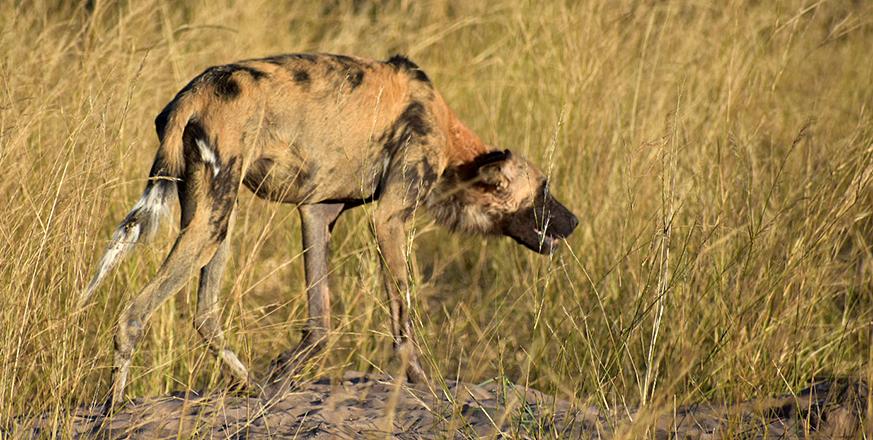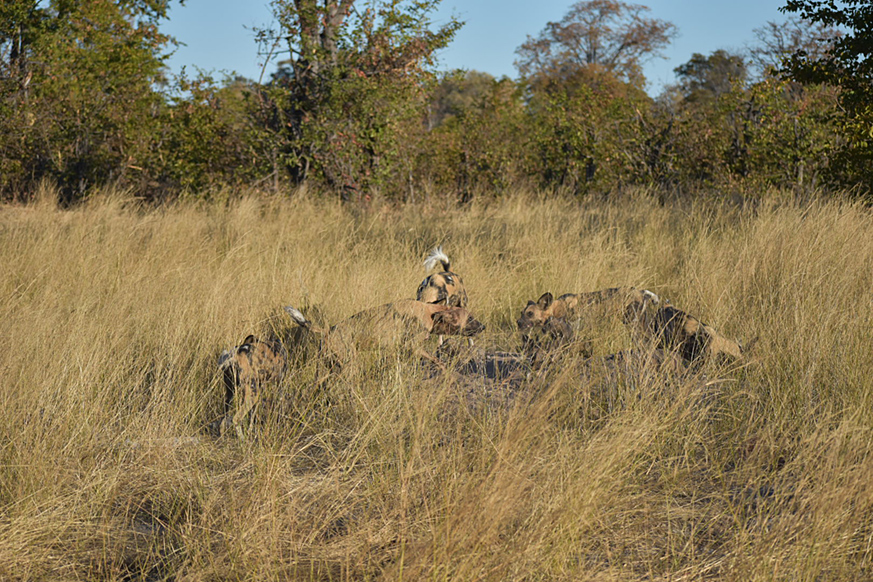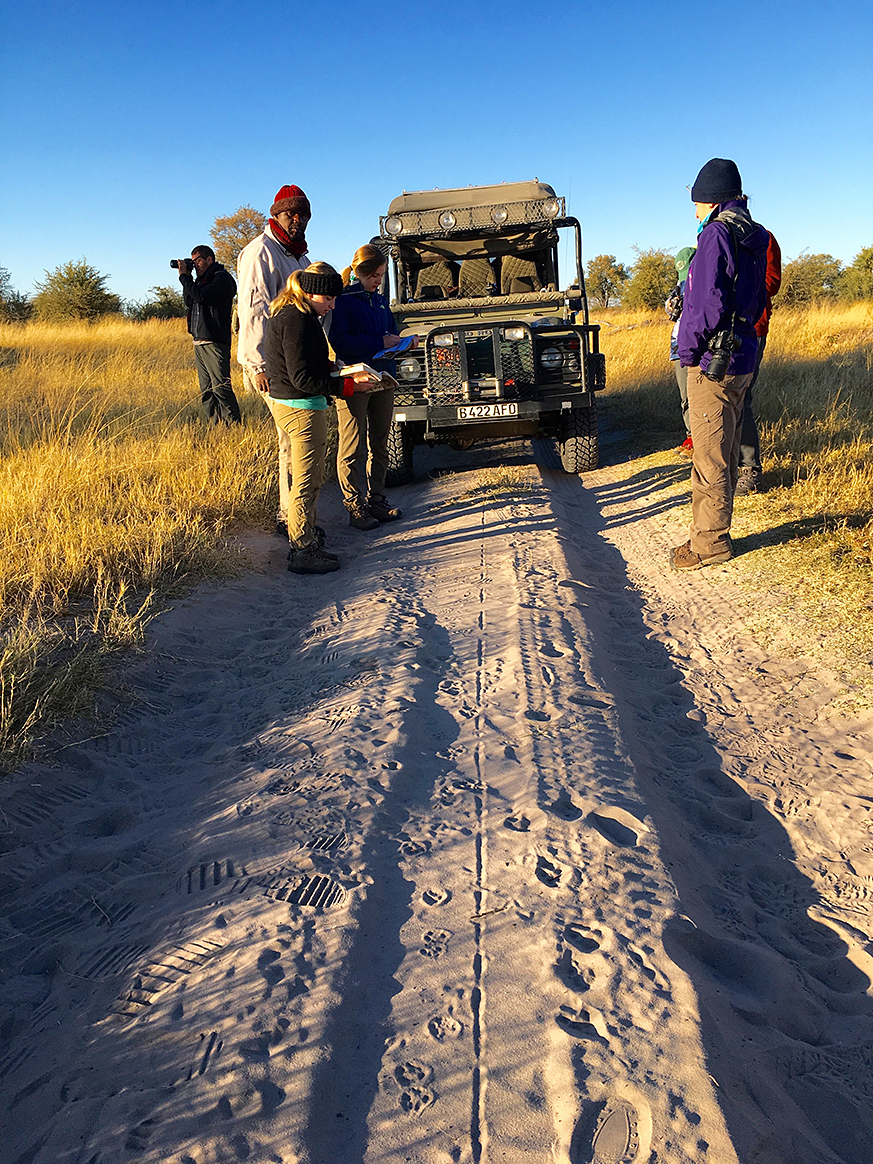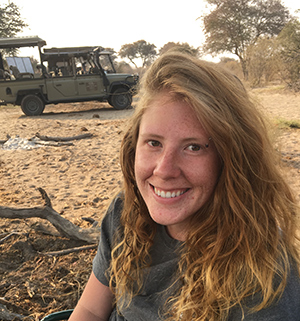Notes from the Field: Ellie Armstrong - Ethical Ecotourism

After seeing some of the adult African wild dogs yesterday, our car was eager to make it to the den to see the puppies. We headed out in the late afternoon, just as the intense heat of the day was becoming bearable. The den itself consisted of a small mound in a clearing just off the road. As we arrived, three cars were already positioned around the perimeter. We learned that the dogs had just moved their den the day before, likely in part because of the pressure from the high density or tourists moving through the park. Right now, we are in the midst of peak tourism season -- and it shows. We rarely go through more than an hour without passing by another vehicle.
Small, short yips quickly drew our attention to 6-7 blackish-brown balls of fur on top of the mound. The puppies are milling about in the early evening, eager for the adults to awake from their afternoon naps. Shortly after, our eyes begin to pick up the well-camouflaged coats of the full grown painted dogs which appear in the grass surrounding the den. One by one, the dogs begin to wake up and drift over to the puppies. Each move is greeted by a sharp increase in volume and customary wild dog greeting behaviors: mouth licking, whining, and yipping submissively towards each other. One puppy tests his luck by grabbing onto the tail of an adult who snaps back with a shrill warning bark, but he is not too affected because after a brief pause he returns to diving on top of his siblings.

More and more adults rise until a large portion of the pack is up and greeting each other frantically. We are lucky to be able to observe some of their typical greeting behaviors. If you watch carefully, you can find the alpha male and female through some of the submissive behavior displays. Subordinate members will mark near the dominant dog or demonstrate a sort of “begging” which consists of licking at the more dominant dog’s mouth corners with their head down, as well as whining. In a final surge, a large group of the dogs come together in a perfect circle with their signature white tails sticking directly up and the puppies in the middle. Soon after, several individuals head off to hunt for the night.
I am on the lookout for a specific dark-colored female dog I spotted yesterday when a portion of the pack quickly passed us on the way to hunt. At first, I believed her to be the alpha female because she showed signs of recently having puppies. However, our guide, Gareth, informed me that she is actually the sub-dominant female. For the past three years, she has had puppies that have either not made it (food is preferentially given to the alpha female’s pups) or the alpha female could have killed them. Based on pack dynamics, it is possible she will move off soon to form her own clan.
I located her off to the side, across the road from the other dogs. I didn’t see any other individuals near her, and no other individual was as far from the main pack as she was. She didn’t get up to greet the other dogs, but remained lying down with one ear perked up and tilted in our direction. She didn’t join the pack for the hunt as she had yesterday. She had not moved by the time we decided to back off from the road surrounding the main den in anticipation that we could track the individuals going on a hunt.

African wild dog social structure is relatively well-studied. There is a dominant male and female which produce pups. Occasionally, a subdominant female will also produce puppies and different litters can have different fathers. Unlike in other canids or felids which form large social groups, the emigrants from wild dog packs are the females. Wild dogs also form particularly large groups when possible -- their survival depends on it. They rely on these large coalitions to take down prey and communally feed the young of the alpha male and female. It is usually thought that most of a clan consists of closely related individuals because of these group dynamics. It makes more sense to help take care of offspring communally if you are more closely related to their parents, and by proxy, also passing down some of your own genes successfully to the next generation. However, there are few data points for all of the stochasticity and diversity of wild dog clans across Africa. In fact, the Zimbabwean pack of wild dogs I used to build several reference genome sequences had a known mother, but an unknown father.
As we sit and observe the dogs, cars continue to pile up around the den even as we backed off significantly. The dogs don’t seem to notice us, yet still, I can’t help but feel sorry for them. My first experience yesterday with them was overwhelming. Three cars were tailing the adults as they headed out for the nightly hunt. Our vehicle faced them head on. They diverted us seamlessly, with as much care for us as water moving around a rock in a stream. If I had wanted to, I could have reached out my hand to touch one.
Lions, elephants, and wild dogs alike in many of these areas have grown up surrounded by vehicles and cameras. The guides are under pressure to deliver and self-drives police themselves in the reserves, so sometimes critical boundaries are crossed between humans and wildlife. Last year, a car drove over the dog den, crushing the puppies inside. And just while we are here, we catch wind that a self-drive vehicle tried to cross a water laden road, got stuck, and a hippo attacked the front of the car. Later today, we observe a guide shine a high-beam spotlight directly on a sleeping hyena. The hyena blinked uncomfortably in the strong light as more camera flashes went on, but she didn’t move.
With photographic tourism already increasing in Africa and it being set to rise considerably over the next decade, as a consumer it is important to be responsible with how we spend out tourism dollars and interact with the landscape. We have to reinforce reasonable human-wildlife boundaries in these spaces. We are lucky to be able to work with seasoned and responsible guides like Gareth and Matuse, who know when to back off and not overcrowd an animal. In fact, this story ends with us retreating to the river to watch the sunset after a large number of cars competed for spots behind the adult dogs on the hunt. I expected myself to feel disappointed that we didn’t get to see the hunt -- after all, we hadn’t seen one yet for any of the species we had observed. Instead, I felt much more at peace known that the dogs might be able to slip away from the remaining cars and hunt in peace, away from the watchful eyes that were constantly on them.
 Ellie Armstrong is a Stanford PhD student in the Hadly Lab
Ellie Armstrong is a Stanford PhD student in the Hadly Lab



